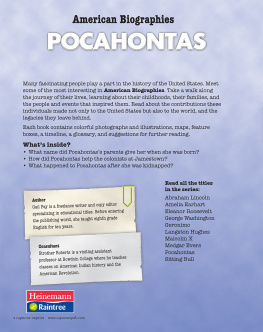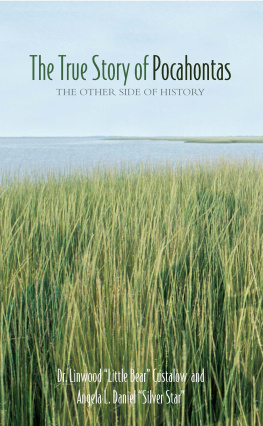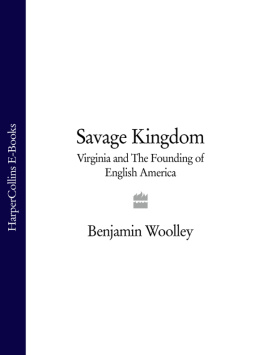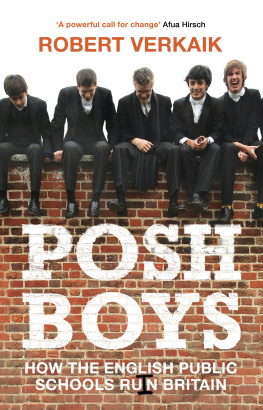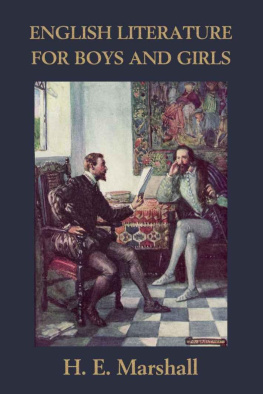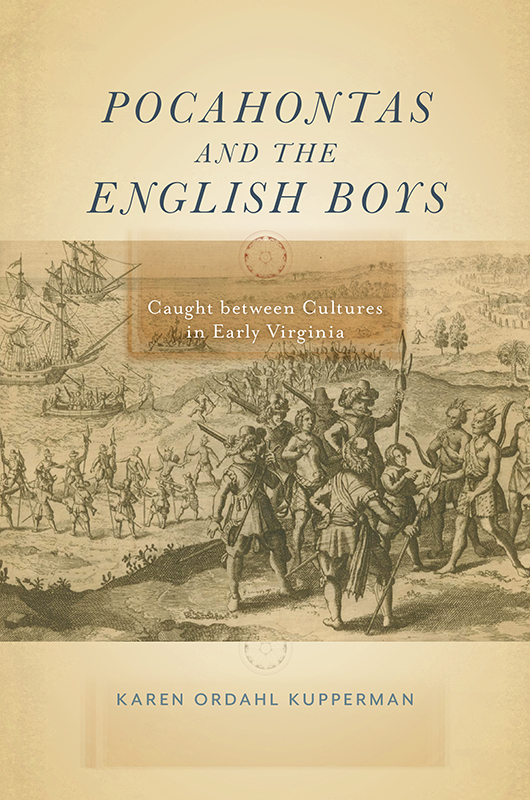
Pocahontas and the English Boys

Pocahontas
and the
English Boys
Caught between Cultures
in
Early Virginia
Karen Ordahl Kupperman

NEW YORK UNIVERSITY PRESS
New York
NEW YORK UNIVERSITY PRESS
New York
www.nyupress.org
2019 by New York University
All rights reserved
References to Internet websites (URLs) were accurate at the time of writing. Neither the author nor New York University Press is responsible for URLs that may have expired or changed since the manuscript was prepared.
Library of Congress Cataloging-in-Publication Data
Names: Kupperman, Karen Ordahl, 1939 author.
Title: Pocahontas and the English Boys : Caught between Cultures in Early Virginia / Karen Ordahl Kupperman.
Description: New York : New York University Press, 2019. | Includes bibliographical references and index.
Identifiers: LCCN 2018037666 | ISBN 9781479825820 (cl : alk. paper)
Subjects: LCSH : Pocahontas, 1617. | Savage, Thomas, 1635. | Spelman, Henry, 15951623. | Poole, Robert, active 17th century. | VirginiaHistoryColonial period, ca. 16001775Biography. | Powhatan IndiansHistory.
Classification: LCC F229 .K88 2019 | DDC 975.501092/2 [ B ] dc23
LC record available at https://lccn.loc.gov/2018037666
New York University Press books are printed on acid-free paper, and their binding materials are chosen for strength and durability. We strive to use environmentally responsible suppliers and materials to the greatest extent possible in publishing our books.
Manufactured in the United States of America
10 9 8 7 6 5 4 3 2 1
Also available as an ebook
Contents
Note on Sources
T HE STORY OF P OCAHONTAS, T HOMAS S AVAGE, H ENRY S PELMAN, AND R OBERT P OOLE has to be pieced together from many disparate, and spotty, sources. For one thing, we have no Native of the Americas speaking or writing in her or his own voice. Sometimes the English sources quote Powhatans, Patawomecks, or Accomacs, but we have to assume those renditions may have been poorly understood and were often tailored to suit the impression that the English author wanted to create.
Henry Spelman, one of this books subjects, was the only person who wrote out of his own extensive personal experience of life among the Chesapeake Algonquians and who had knowledge of at least two American languages. His memoir was not published until the nineteenth century; but many people interested in America had seen it, and some quoted from it.
The English sources consist broadly of the following general categories. One is Englishmen who made a business of collecting travel accounts. The first, a clergyman named Richard Hakluyt the younger, was inspired by his cousin, also named Richard Hakluyt. Hakluyt the elder was a lawyer with many friends among London scholars who were interested in cosmology. The younger Hakluyt began collecting notes from sailors and other adventurers while he was a student at Oxford in the 1570s. His first work about exploration, Divers Voyages Touching the Discoverie of America, and the Ilands Adiacent, was published in 1582. Hakluyt went on to publish massive collections of travel narratives: The Principall Navigations, Voiages, Traffiques, and Discoveries of the English Nation in 1589 and updated as The Principal Navigations Voyages, Traffiques, and Discoveries of the English Nation in 15981600. Hakluyt sometimes interviewed returning voyagers in order to get the most complete accounts.
Richard Hakluyt died in 1616, while Pocahontas was in London, but early in the seventeenth century, he quit publishing travel accounts and turned his manuscripts over to the man who is considered his successor, Samuel Purchas. Purchas was the minister at St. Martins Ludgate, which was a near neighbor to the Belle Sauvage Inn, where Pocahontas and her entourage were lodged. Purchas continued Hakluyts methods of thoroughness in searching out accounts, and his volumes included pieces from sources, including Spelmans, that were not published until the nineteenth century. His first collection, published in 1613, was titled Purchas His Pilgrimage, and several more editions followed. Then, in 1625, he published his major collection, Hakluytus Posthumus, or, Purchas His Pilgrimes, which extends to twenty volumes in its modern edition, and it includes all the reports he could gather from the Jamestown colony.
Two men who spent time in Virginia also created collections of experiences in the colony. Capt. John Smith went with the original ships and stayed in the colony just over two years. From 1610 forward, with the exception of a brief reconnoitering trip to New England, he carved out a career as a writer and theorist of colonization. As he reminded his readers, I am no Compiler by hearsay, but have been a real Actor. Unlike Hakluyt and Purchas, he wove the reports he collected into a coherent narrative, and he named his sources, usually people still in America, at the end of each section. His first several books were about Virginia, and he then turned his attention to New England. He invented the name New England to support his argument that that region was more suitable to English bodies than Virginia was. In 1624, he published his grand history of all the colonies, and he argued strongly for a plan in which ordinary English men and women could have land of their own and a degree of self-government. During his decades as a literary man in London, he formed connections with many people who were influential in cultural and colonization circles.
William Strachey also formed the fruits of his own observations and the reports of others into a coherent description of Virginia. He was in the flagship wrecked on Bermuda in 1609, so he spent his first year in America there. He arrived with the others from Bermuda in spring 1610 and returned to England in late 1611. Although his Historie of Travell into Virginia Britania was not published until the nineteenth century, many people had access to the manuscript, and it offers an unparalleled compilation for modern readers.
Another important source is letters written by colonists, many of which were published by the Virginia Company once they had arrived in London. Those that were not published presented views or information that the company did not want to get around.
The final important source of information is official reports and records of meetings of the governor and council in Virginia. These, of course, present a version of the facts that the colonial government wanted the sponsoring company in London to believe, but the testimony presented by individuals gives modern readers insights into where people were, what they were doing, and how they related to other colonists. Susan Myra Kingsbury spent countless hours transcribing the records, and her transcriptions were published by the U.S. Government Printing Office in four volumes between 1906 and 1933. More recently, David Ransome has discovered and transcribed many other papers that are part of the Virginia Company archive, and these are available online as Virginia Company Archives: The Ferrar Papers FP 1FP 2314, Ferrar Print 1-562, 15901790, published by Adam Matthew Digital.
Next page

